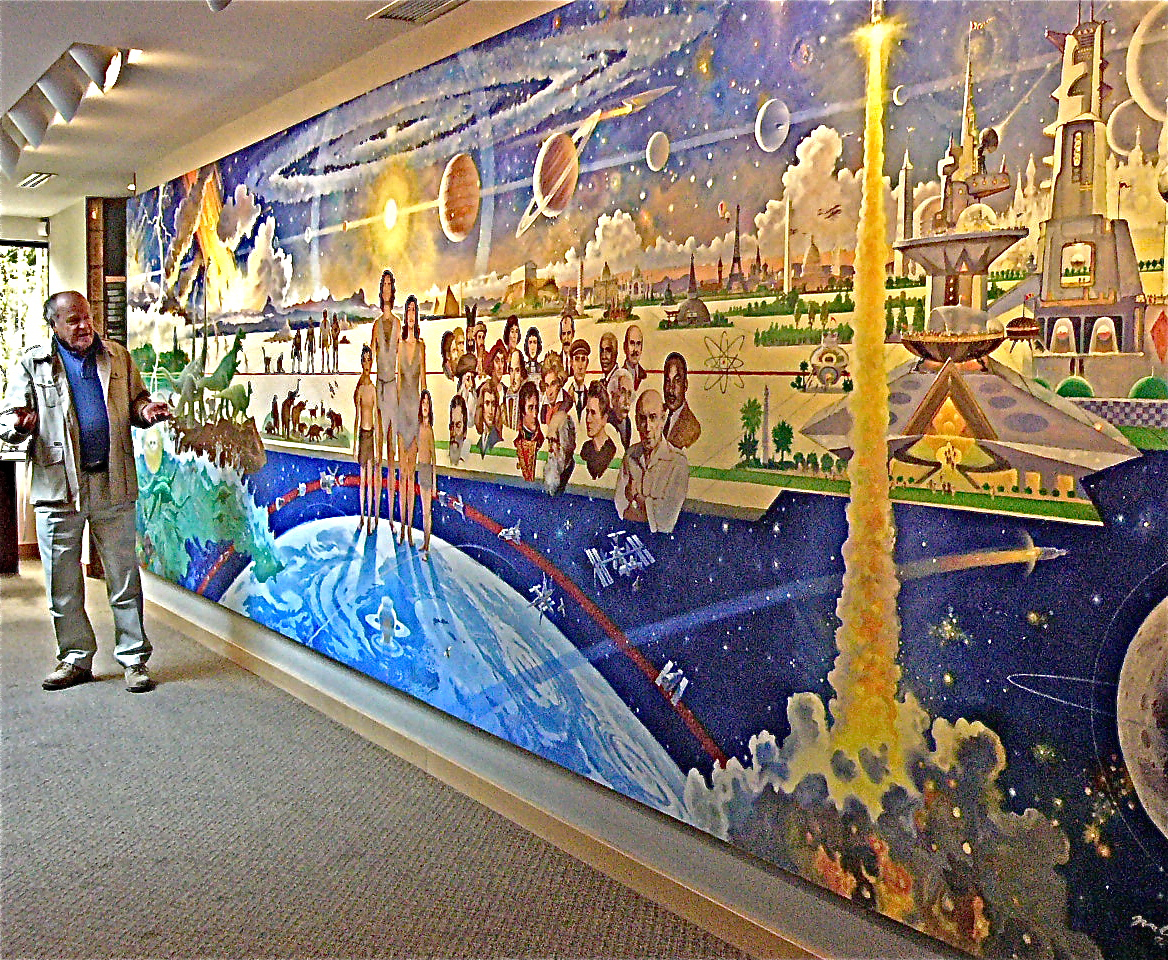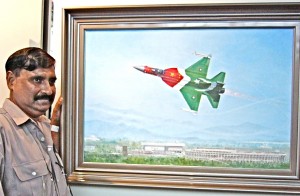By Jack Elliott
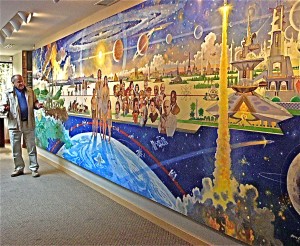
Bob McCall speaks to ASAA members about his mural, “Cosmic Revolution,” in the Bellevue, Wash., headquarters of The Foundation for the Future.
Attendees at the annual forum of the American Society of Aviation Artists, held in Seattle June 16-21, got a doubleheader. The Museum of Flight hosted the forum, a gathering of aviation artists from the U.S. and other countries. The second major attraction centered around the Boeing company’s massive plant in Everett, Wash.
Artist members had an opportunity to submit works for consideration for a juried competition. The 57 works selected went on exhibit in the museum’s Great Hall, where they’ll remain on display through Sept. 14. None of the art at this event is for sale, as the ASAA is strictly an educational organization.
The importance of aviation artwork
The ASAA juried exhibition features works by some of America’s top aviation artists as well as painters from abroad. The ASAA has four categories of membership: artist fellow members, whose work is widely recognized for superior quality and consistency; artist members, who must submit five aviation paintings to become eligible; foreign affiliate artist fellows or artists; and associate members, who may be friends, students, collectors or supporters of ASAA activities.
Among the paintings by ASAA members exhibited in the museum is an unusual painting by Pakistani artist, S.M.A. Hussaini. It’s a painting of the JF-17 Thunder, a joint venture of the Chinese and Pakistanis. The front section of the aircraft is painted red to represent the Chinese contribution to the project and the rear is painted green for the Pakistanis.
Four other foreign artists had entries in the juried competition. The entry of Giampaolo Baglioni of Brazil was an acrylic titled “Survivor,” of a 1944 twin-engine reconnaissance and attack aircraft, designated the A-20K. Frenchmen Jean Barbaud’s ink and watercolor, “Morane Knight,” shows a pair of WWI Morane N fighters flying above the battlefield at dawn, and Canadian Cher Pruys’ watercolor entry, “Remote Waters,” shows a Cessna Caravan on floats a few feet above the water in a picturesque scene. The acrylic of Ronald T. K. Wong of England depicts two Spitfires of the Israeli Air Force flying over Masada.
Keith Ferris of Morris Plains, N.J., one of the founders of the ASAA and a former president, was represented in the exhibit with two paintings. “Skylab in Orbit,” depicts the spacecraft in orbit, 272 miles above the Earth in 1973, demonstrating that man can live and work in a weightless environment for an extended period. His other painting, “Knight Intruders,” shows two B-57s on the first night mission over Laos on April 1, 1965; led by a C-130 flare ship, a Marine Douglas EF-10B Skynight brings up the rear to block radar.
Mike O’Neal, treasurer of the ASAA and one of the leading WWI artists and historians in the nation, entered “Valentine’s Day.” His painting depicts Lt. Valentine Burger, flying with the French Escadrille C.46, downing a German ace on Aug. 11, 1918. Valentine was a New Jerseyan, as is O’Neal.
Erik Lindbergh, the grandson of Charles A. Lindbergh, had two sculptures in the exhibit: “Time Capsule Rocket Ship” and “Blue Skies,” a bronze version of the aircraft he flew across the Atlantic in observance of the 75th anniversary of his grandfather’s historic flight.

Ronald T.K. Wong of England displays his painting, “Merlins Over Masada,” depicting two Israeli Air Force Spitfire Mk.IXs flying over historic Masada.
American artists won the two top prizes in the juried competition. Sharon Rajnus of Malin, Ore., won the Best Painting in Show award, carrying a prize of $1,500, for “Boeing PB-1—U.S. Navy 1926,” showing a flying boat taking off from rough water. The Award of Distinction, a $1,000 prize, went to Jack Fellows of Lake Stevens, Wash., for his painting, “Corsairs,” showing two Corsairs in flight. Two artists earned merit awards of $500, including Paul Burrows of Summerville, S.C., whose painting, “Going Nowhere,” shows a homebuilt Bowers Fly Baby. Russell Smith of Matthews, N.C., depicts Lt. Kurt Wolff’s last flight in his painting, “Wolff’s Requiem.” Wolff was flying a prototype of the German Fokker F.1 triplane when he was shot down in a fight with Sopwith Camels on Sept. 15, 1917.
The forum also held an informal non-juried competition for the Founders Awards. Steve Anderson of Chino Hills, Calif., won the gold award for his detailed model of a Fokker DC.7. The silver went to Steve Woodcock of England, for his stylized painting of a Phantom. Peggie Foy of Medford, Ore., took the bronze for her painting, “Misty Morning,” which showed a flock of pheasants being flushed out of a stand of tall grass by a biplane taking off.
During the forum, various artists including Lindbergh spoke about their work and techniques, so attendees could learn how fellow artists approach their creations.
Inspiration
The Museum of Flight, headed by Dr. Bonnie Dunbar, is the largest private aviation museum in the world and an affiliate of the Smithsonian Air & Space Museum. While at the museum, the artists spent part of one day painting subjects of their choice.
Aviation art has produced many memorable works, but even more important is its vivid recreation of aviation’s colorful history. The artwork often places the viewer squarely in the middle of major events in the development of aviation, from the Wright brothers to supersonic passenger aircraft and even historic ventures into space.
Two of the most popular subjects of aviation artists are the aerial battles of World War I and II. In recording military aviation missions, artists often spend countless hours going through old records and debriefing documents in order to recreate aerial battles with the most precise accuracy, down to the exact time of day of a mission, so they get the lighting that existed just right.
The U.S. produced many extraordinary aircraft during WWII, inspiring numerous riveting paintings and spurring great interest among the public. Many of the legendary aircraft that were subjects of outstanding paintings are on view in the museum’s Personal Courage Wing, which highlights the stories of courage, dedication, heroism and human spirit of those involved in World War I and II.
The WWI aircraft include a Fokker D.7, the Albatross, SPAD, Sopwith Camel and Nieuport 28. The display also includes the only Italian Caproni 20 ever built, in 1914, which is credited with being the first fighter plane of WWI.
The WWII collection includes many foreign aircraft, such as the German Messerschmitt 109, the Russian MiG and the British Spitfire, in addition to the U.S. Air Corps’ P-38 Lightning, P-40 Warhawk and P-47D Thunderbolt Razorback.
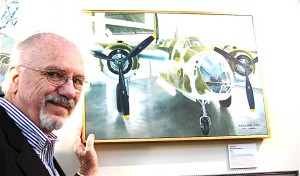
Brazilian artist Giampaolo Baglioni’s painting, “Survivor,” depicts one of 16 A-20 Ks that served with a Brazilian light bombardment group from 1944 until it was decommissioned in 1955.
The Great Hall has 41 aircraft on display, including military and civilian models. Twenty-two of these are suspended from the ceiling, including a 1935 DC-3. Another special aircraft on display is the only Boeing 80A trimotor in existence. But the centerpiece of the aircraft is the only surviving M-21, the predecessor of the famed SR-71 Blackbird spy plane, which could reach an altitude of 85,000 feet and achieve speeds of Mach 3. Lockheed built only two of the aircraft, and the other was lost in July 1968.
Another unusual feature is the Red Barn, Boeing’s original factory, which adjoins the museum. The Red Barn, a large wooden structure painted bright red, was the birthplace of Boeing in 1916, and is the oldest aircraft manufacturing facility in the country. The building served as Boeing’s headquarters until 1929. Originally two miles up the Duwamish River, the building was barged down the river in 1975 to the site of Boeing Field, and the museum was later built adjacent to it.
Some of the machinery that was in the original plant, such as a wood lathe and planer, were replicated to recreate the atmosphere of the original plant. Many photographs and exhibits detail the growth of Boeing over the years.
Outside the museum’s front door sits a restored DC-2 in TWA livery. Only four DC-2s are in existence; The Museum of Flight restored its aircraft to flyable condition. In an airpark across the street from the museum, a collection of aircraft features the only Concorde west of the Appalachians and the first Air Force One, a Boeing 707 that saw service from 1959 to 1996. It replaced President Eisenhower’s Super Constellation. Another historic aircraft in the park is the prototype of the 747.
Boeing tour
Boeing hosted the group on a tour of the biggest manufacturing factory under one roof in the world, which encompasses 98 acres and is 11 stories high. Six hangar doors—each the size of a football field—open into a building the size of 74 NFL football fields.
The 747, 777 and next-generation 787 Dreamliner are built in this plant. To view the production line, guests take a long walk through a huge tunnel, finally arriving at an oversized freight elevator that deposits its riders on a mezzanine. On this particular day, visitors looking down at the production line saw four 787s in a line, all in advanced stages of production, including the one rolled out for Boeing’s first public showing on July 8, 2007. On the day of the tour, the electrical system for that 787 was fired up for the first time.
Also in sight near the 787 were dozens of engineers at their computers. The 787, like the 777, is entirely computer-designed.
The Museum of Flight Restoration Center
Another point of interest in Everett, just a few miles from the Boeing plant, is The Museum of Flight Restoration Center. Some 1,200 volunteers, many of them former Boeing employees, work here in what is a genuine labor of love.
Among the aircraft the volunteers are working on is a British Comet, the world’s first jet transport. The aircraft had metal fatigue problems; when the Boeing 707 came along and became the preeminent jet airliner, the modified Comet faded from the scene. They’re also rebuilding a prototype Lockheed JetStar, one of the earliest business jets. Two JetStar prototypes were built; both had two engines mounted on the fuselage. On one of the prototypes, four engines replaced the original two. All of the production models had four engines. The JetStar at the museum’s Restoration Center, which has two engines, was the personal aircraft of Kelly Johnson, who ran the Lockheed Skunk Works.
Another rare aircraft in restoration is an XF8U-1 straight-wing Corsair, predecessor to the F-4U gull-wing Corsair of WWII. Based at the center is a restored Boeing 247 airliner, predecessor of the DC-3. It’s the only one left and it’s in flying condition.
A special bonus
ASAA members also visited the Foundation for the Future in Bellevue, Wash., a 12-year-old, high-level, well-funded organization, whose mission is to “increase and diffuse knowledge concerning the long-term future of humanity.”
Founder Walter Kistler, a scientist who’s patented many inventions used on space missions, serves as president of the foundation. The organization has worked with UNESCO and other major organizations in sponsoring workshops and seminars for scientists and scholars all over the world. It’s awarded cash prizes—sometimes in the six-figure range—for outstanding scientific achievements.

Mike O’Neal, WWI artist and historian, shows his painting, “Valentine’s Day,” which shows Lt. Valentine Burger downing a German ace.
The magnet that brought the ASAA group to the foundation was a mural created by one of ASAA’s founding members, Robert McCall. One of the nation’s outstanding space artists, McCall has done a great deal of work for NASA and for the movie industry’s futuristic productions.
Mounted on the wall of a large room in the foundation’s headquarters building, “Cosmic Revolution” depicts the development of the universe from its origin to futuristic space vehicles that resemble next-generation flying saucers.
McCall, who is 88, discussed his work with the energy and enthusiasm of a teenager. His outlook is constantly on the future and his attitude is strongly optimistic. McCall’s mural begins with the Big Bang forming the universe. Below it is what he describes as “the unbelievable, magical moment when one cell became the first to replicate itself, and life on Earth began.”
At the left side of the painting are dinosaurs and primates in various stages of development, ending with man. The very center of the mural depicts a modern family group, which McCall describes as “proud, optimistic and strong, looking into an unknown future.” They’re standing on a globe with an atomic symbol erupting out of the ocean. It’s a symbol of humanity’s progress, and a reminder that all progress carries with it both good and bad.
To the right of the family are symbols of some of mankind’s greatest monuments, including the pyramids, the Taj Mahal, St. Basil’s Cathedral in Moscow, the Acropolis, St. Peter’s Basilica, the Eiffel Tower, the U.S. Capital and the Washington Monument.
In one section of the mural are portraits of the great personages of human history. Included are Plato, Socrates, Aristotle, Confucius, Leonardo da Vinci, Galileo, Johann Guttenburg, Christopher Columbus, Newton, Copernicus, Shakespeare, Joan of Arc, Napoleon, Beethoven, Darwin, the Wright brothers, Madame Curie, George Washington Carver, Einstein, Picasso and Martin Luther King Jr.
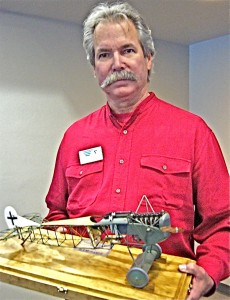
Steve Anderson holds his prize-winning model of a Fokker D.1, which depicts the construction of the aircraft and has a tiny, but remarkably detailed, engine.
Although McCall has completed hundreds of space paintings and other murals, it was obvious that he takes special pride in this work.
The ASAA shares McCall’s optimistic view of the future, and with that in mind, it’s already planning for next year’s forum, which will take place in Savannah, Ga., home of the Mighty Eighth Air Force Museum.
For further information about ASAA, visit [http://www.asaa-avart.org].











